Olympic dressage rider Courtney King-Dye talks about her accident, her rehab, and becoming a para rider.
Images by Susan J. Stickle
At the 2008 Olympics, Courtney King-Dye was the youngest member of the United States dressage team and was considered one of her country’s riding international stars with a bright future ahead. Less than two years later, her plans came to a screeching halt. Training at home, the horse Courtney was riding tripped, and the pair fell. Courtney hit her head and suffered a traumatic brain injury. While she was in a coma, it was feared she would not wake up.
A month later, the fears turned to hope as she gained consciousness and headed to rehabilitation. It is now nearly three years since the accident, and Courtney is writing her own story. She is back in the saddle, with her eye still on the competition ring – but with a few changes. Because all four lobes of her brain were injured and she has limited use of her body, Courtney’s goal is to represent her country again, but as a para-rider.
Courtney – Her Story
My accident happened in March, 2010. I didn’t fall off, and my horse did nothing naughty. He just tripped over his own feet and fell, and my head hit the ground hard. Hence my motto: expect the unexpected. I was not wearing a helmet, and my brain sheered, or bounced around, in my skull.
I was in a coma for a month. I had to relearn to do things like walk, talk and eat.
I am doing well, thanks to my husband Jason [a New Zealander], my mentor Lendon Gray, my working student Koryn Staehling, my assistant Jennifer Marchand, and friends who have done so much to help me with every little thing.
There also have been many people I’ve never met who have sent encouraging emails, cards and financial aid. Without them, my therapy would be drastically reduced. I owe them many thanks.
The most important goal for me was, of course, to recover. But as I began recovering, it also became important to get back on a horse – a quiet horse. Then it became important to ride a quiet dressage horse. My dad and stepmom expressed their concern at having me in the saddle again, but they said if I choose to do it, they’re behind me 100 percent. Horses are a risk even for the able-bodied. But if I stay off a horse, it would feel as if I had locked myself in the bedroom, afraid to come out for fear that something may fall on me, I so appreciate my loved ones’ fears, but if I don’t ride, I don’t live, and they know that. I make sure everything is as safe as possible, but I know as well as anyone that horses are unpredictable. It’s a risk all riders choose to take for the passion.
In rehab, I learned that hippotherapy is used by therapists (physical, speech and occupational). The movement of the horse helps improve a person’s motor functioning. I have developed my own type of hippotherapy combined with therapeutic riding (which is riding within your disabilities). Here are some of the things I’ve learned:
Training the body is similar to training a horse
Dressage horses are meant to move fancy and be responsive to the rider’s aids. Therapy horses are meant to take care of their person. The horse I ride twice a week, Roxy, has the training of a dressage horse and the heart of a therapy horse. These photos were taken in summer 2011, and I like to think I’m further ahead now. I still can’t trot on my own, but I have a blast nevertheless.
My right side, including my leg and arm, is my weaker side. My left side is also affected because my whole brain was injured, but my right side is worse.
I tell you this because it taught me something about training. One day, my working student Koryn was helping me walk around the yard without my cane as she often does, and I started to think that there are so many similarities in how I train my body to how I train a horse. So I asked Koryn if helping me and seeing how I worked on myself helped her in training her horses and being a better student. She said it absolutely did.
If I’m not happy with how I’m walking, I often just stop walking, stand there, take a deep breath, re-collect myself, and fix the thing I think is a problem (like my left shoulder is too high) and then I continue to walk, thinking only about left shoulder down. With horses, I may not completely stop, but I’ll stop doing that exercise for a moment, maybe do a 20m circle and just focus on the issue I’m not happy with. For instance, if I’m not keeping my weight to the inside enough in the half-pass, I’ll just do a circle, completely exaggerating putting my weight to the inside.
Another similarity is that focusing on and fixing one problem will often help solve others. For instance, in my recovery I have been told my many people to put weight on my right leg, as much as I tried, I couldn’t. Then one therapist told me to leave my left foot on the ground longer and not take a step so quickly. To my amazement, this made me shift weight to my right leg without thinking about it. It makes perfect sense: making my left toe stay on the ground necessitates taking weight on my right leg; leaving the toe on the ground longer gives my body time to shift the weight.
When riding, let’s say your right shoulder is up and you try to put it down, but it won’t budge. Right shoulder up means you many be putting all your weight on the left sitting bone. If you tell yourself to sit on the right sitting bone, this may allows your right shoulder to come down naturally.
Learn to follow the movement
I have this little machine that I sit on, and it’s supposed to move like a horse and exercise my abs. I tie reins to it, turn it on and sit in a chair, holding the reins. I practice following, which my tright arm is still too tense to do properly. I also sit on the ‘horse’ when it’s moving and have Koryn hold the reins, She pulls just like the horse’s head, and I follow her. While doing this, I realised I was artificially following – knowing the rhythm and making my hands go back and forth. And it dawned on me that this is exactly what I see people on real horses do. I had to focus on exactly the same thing I tell students. The hands are heavy, dead weight. To avoid this artificial following, I had Koryn completed ignore the rhythm and just pull my hands, sometimes separately, making my arms follow her movement.
When I was first a working student for Lendon, she told me all I needed to learn to follow. So on all my horses, I would take contact with the mouth and not ask for anything. If he swung his head right to look at something, my left hand would have to follow forward to allow him to look, and my right hand had to come back to avoid slack and keep contact. Both reins had to have identical contact with the horse’s mouth at all times.
Here’s another way to think about it: imagine that your elbows feel slightly heavy, as if they have small sinkers from the end of a fishing line attached. They are just heavy enough so they take up the slack in the rein and allow you to follow with elasticity.
Just do it
I often write and talk about the analytical necessities of riding. But today when I was practicing walking, I realised I completely neglected discussing one essential. Often when I’m walking and my balance gets wonky, I’ll stop and try to fix it, and it will still be wonky. So now I’ve learned to stop, take a deep breath, relax and think, ‘just walk to that tree’. Manytimes I will continue with much better balance.
‘Just do it’ is one of Lendon’s favourite phrases. Forget about working on your problems; just do the half-pass or whatever you’re doing.
It’s important to focus on problems, but it’s equally important to leave them be and let muscle memory take over the job you’ve worked so hard on. One of the crucial benefits is that it allows the body to relax. Often, over-concentrating creates tension. Just doing it and not focusing on problems allows the relaxation to return. I think of it as shrugging, then going back to concentrating on the problem at hand.
Some people ask me if it’s hard to be where I am now, after being an Olympic rider. The answer is no, I never even think about it. I may be working on different things, but I’m still working on things, and that’s what I’m used to and love. I don’t compare how I was before my accident to how I am now. I compare how I was post-accident to how I am now, and sitting on a horse at all is far better than sleeping my days away. Besides, it’s all about the joy of being around horses.
The Paralympics
By October 2011, I had graduated to more therapeutic riding, where, instead of the focus being on using the horses’ movement to help my motor functioning as in hippotheraphy, the emphasis is more on teaching me to ride within my disability. I still do a special combo of the two. It’s all a very slow process, but I’m used to long-term patience from training horses.
I made the decision to try to get in the US paralympic team, and was very fortunate to be bought the perfect horse by Jane Forbes Clark. I named him Make Lemonade because that’s all you can do if life hands you lemons.
He is exceptional: beautiful, great walk and super-kind. Part of what makes his walk fantastic is what makes him a challenge for me to ride. He’s loose and supple, which makes the reach big. That, added to the sensitivity I love, make walking in a straight line incredibly difficult. His sensitivity makes my wonkiness affect him a great deal.
I can’t tell you how great it feels to have something to work toward, something to strive for. Whether I make it or not is somewhat irrelevant. I’ve spent the past three years working on therapy, giving all of my time and attention to getting better. In a way, it feels like that was surviving. This is living.
Mounting and warm-up
I say my hellos to Roxy, which not only warms my heart, but also (according to the physical therapist), allows the mare to see the person she’s going to be taking care of. I’ve only ever met one horse with a heart like Roxy’s; my Olympic partner, Mythilus. Roxy only wants to please and be good. She never wants to get out of doing anything.
The owner of the barn, Clair Glover, had a special mounting block built for me. It has room for a side walker to stand with me. As I mount, Koryn (in the pink shirt) takes my right leg and hands it to Jen, on the other side of the saddle, so it can be placed in the stirrup.
Then we’re off. The first thing I do is let my body absorb the motion of the walk. The motion created in your hips is the same as when you’re walking, so I let my arms hang down, and they naturally swing as if I were walking. Sometimes we walk over poles and this exaggerates the walking movement.
Loosening exercises
To stretch all my pieces and parts, I reach all the way forward toward Roxy’s ears and all the way to each side, with my side walkers, Jen and Koryn, pushing my heels forward.
Then I stretch all the way back to Roxy’s tail. I call this my mud flapper pose. It looks easy, but my right arm (which I call Righty) wants to clench tight like a wing because of spasticity, so it’s really a challenge to get him to let go and extend.
I then put my arms straight out to each side and twist around each way, first at the halt and then at walk. Although this is a good challenge to keep my wing arms outstretched while my brain is working on other things, the purpose of this exercise is to allow the horse’s motion to encourage mobility in my hips and waist.
Then, I do a two-point seat to try to get my heels to go down. My left heel is down but my right toe wants to be down like a ballerina’s. I am wishing my heel down in the mirror. I’m also trying to keep the small of my back flat because it wants to arch.
Taking the reins
Now I get to take the reins. You’ll notice I have Roxy in a bitless bridle because Righty’s ability to follow is a work in progress. And now I try to do some lateral stuff in the hope that muscle memory wakes up a bit. I think Roxy half guesses what I want, but the organisation of using different aids together is highly valuable.
When I do a leg-yield to the left, my right leg (which is the weaker) wants to clamp on, but I force him to press, release, press, release and so on. It’s my good fortune that Roxy understands. You’d think it’d be more challenging to leg-yield off my weaker leg – and with most horses it would be – but not with Roxy. She is quick to decipher what I mean, so my greater challenge is to use the right leg when I’m leg-yielding off the left to monitor the straightness and the amount of sideways.
Then I attempt shoulder-in to the left . My weaker right hand has to press against the horse’s shoulders to ask them to come in while my left leg keeps her path going straight. Both directions provide an excellent challenge. The left one teaches Righty subtly. He wants to just clench on, but he has to allow enough for the bend and not make Roxy stop. To the right, my right leg has to ask Roxy’s barrel to go left, keeping the path we’re travelling straight and making her body bend.
This story appeared in The Horse Magazine May 2013 – it originally appeared in Dressage Today, reproduced with permission…



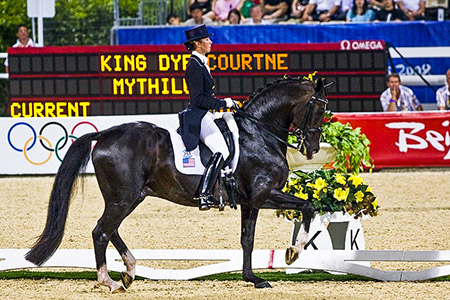
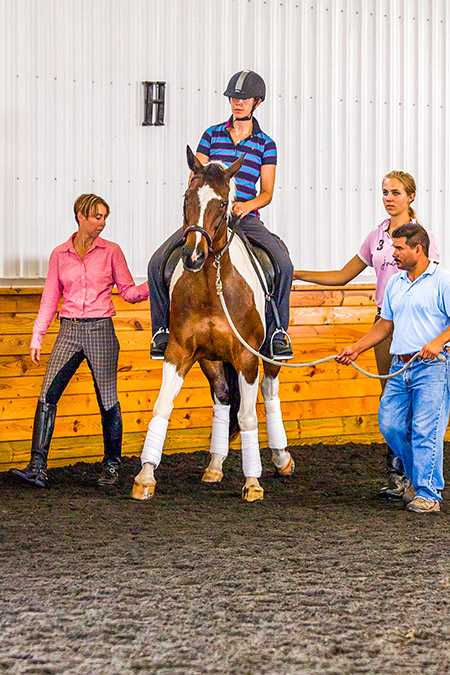
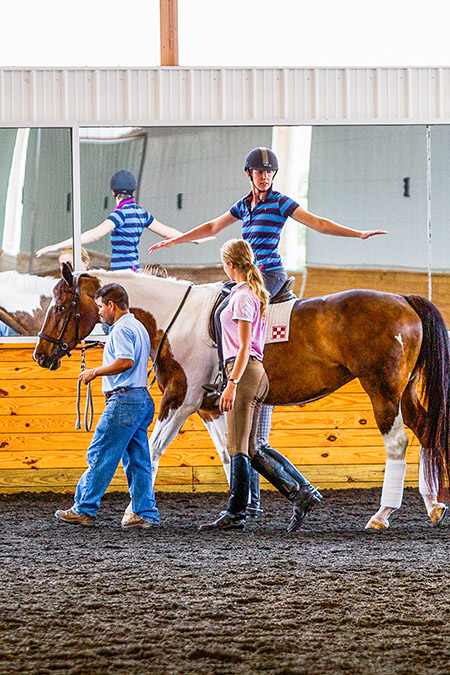
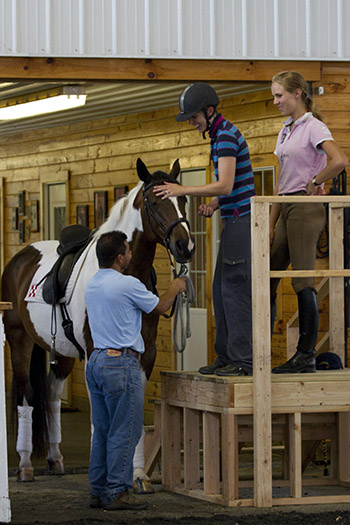

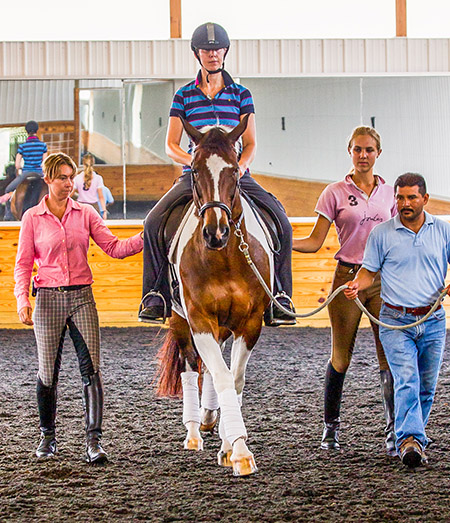
Courtney you have the most beautiful posture on a horse, “all that muscle memory !!” , I firmly believe horses help us heal both physically and emotionally, keep up the good work, you will also be in my prayers, “Keep the Faith” , Sincerely, Betty Faust Gainesville,Fla.
I am so impressed with your progress, your courage, and your thoughtful article. Keep up the work, I believe the muscles will remember, and perhaps even help to retain your brain to use different pathways.
Once a horse girl…..always a horse girl 😄😄 beautiful article…
Your Training and explanations of what is taking place can be used by anyone trying to get the balance and finesse needed to ride. Thank you for your wonderful words. Cindy Sours.
Your faith, trust and love in the healing power of the horse is both inspiring and beautiful. Thank you for all that you are.
Thank you Courtney… for everything. I know you might not get this but I wanted to let you know I am riding a lot better thanks to you. So I owe everything in my success for this year to you and I hope to bring my own horse next time I train with you.
– Paydan McLaughlin
Oh and Delilah the horse
Courtney, Love reading your coming back article. You are an inspiration. I am a 71 yo rider who suffered a TBI with brain bleed. Hospitalized a week, had to stop working and also have physical therapy. Tho brain wise things aren’t perfect, after 3 years I am riding again intro/training dressage, and find that my gelding helps me a great deal by letting me know when things don’t feel right, so I can correct and help myself to align my body properly. I have compared my “inabilitys” to how I used to ride and become frustrated however, so your ability to not compare and just enjoy inspires me.
I always considered Mrs King Dye the most soft natural & beautiful rider ever in the Dressage arena. No other exhibitor came even close.
Her commitment then as our top competitor shines through now You will succeed at all you have chosen to do. You are a gem of a lady inside & out. Best Wishes …Onward Courtney
Reach for the Stars !!!!
Sincerely, Sharon Hohenberg
Wow, I am impressed, I love how you approach your challenges. I also have experienced multiple head injuries and severe PTSD Trauma. I wanted to share a few things with you that are helping me. As far as teaching dressage: I use ‘pull your toes up’ versus ‘push your heals down’. It makes for a deeper and more secure seat. Pushing your heals down will actually push yourself up in the saddle. If your inside shoulder is down, instead of ‘lifting it up’, try ‘lowering your outside shoulder’. This helps to correct your balance and lengthens your inside and brings your upper body out of a collapsed inside hip as well.. To stand and sit straight up you can do this exercise : lift both shoulders, roll them back, picture the lower point of your shoulders squeezing together and take a nice deep breath and just relax and let your shoulders drop straight down. Keep your head up while you are doing this, This helps your spine to go into neutral and you are offloading pressure in muscles and around joints. I also use a small device called OSKA, and sleep with it underneath my pillow. My brain function has improved and my PTSD has become more manageable as well. You can strap it anywhere on your body and yes, you can ride with it as well. I ordered it at oskawellness.com Use promocode JUMP10 and you will get $55 off.
Keep up the awesome work, I would love to see you in your next Olympic adventure 🙂
Oh, here’s one more tip you can use when you are walking or riding. Focus on having weight on the toe next to your little toe, I learned this in a Feldenkrais group session. You may want to check into that as well to help retrain your brain!
This is a very inspiring women. The article was fantastic with the similarities and differences: not only for Courtney but also for the horses. Every time someone shares a story of how a movement or a thought changes a horse: I feel like a WOW button goes off in my head.
You should think about her writing a 3-5 page article for you guys 4 times a year. I love to keep track of her progress, but more importantly, I’d love to hear about what she continues to learn about her body, the horses body and the two combined.
Excellent article Courtney. I hope you continue to improve. I am a pararider with MS who discovered Working Equitation 2.5 years ago. It allows me to keep competing. I use two curved whips to give cues to my horses. Each whip tap has a meaning. I also use secure seat velcro to help keep me in the saddle. I would love to know more about what equipment you use that help. So many of your comments hit home in this article. I know exactly how you feel. Thanks for keeping up the fight and God Bless horses!